
I wanted to give you my “signature” recipe for Chicken Stock (I call 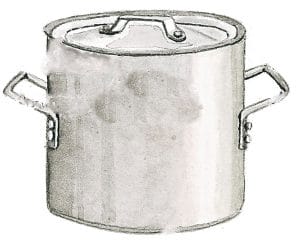 it that because I’ve made it so often that I can do it by heart); deep, dark, and delicious, full of vitamins and rich in flavor, the basis for so many wonderful dishes. The stock takes two days to make, which is why you may have seen the recipe but didn’t try it — I just want to encourage you — it’s SO worth it! Most of the time it’s just bubbling cozily on top of the stove making the house smell wonderful while you’re going about your business. The good thing is, you end up with lots of stock; enough to make a soup that will last for days, enough to do that and to freeze some if you want — I use it to make our favorite chicken soup that’s as good for breakfast as it is for dinner. (Soup for breakfast is delicious on cold winter days! Corn Chowder or Butternut Squash, yummmy!) So here’s how to make the stock:
it that because I’ve made it so often that I can do it by heart); deep, dark, and delicious, full of vitamins and rich in flavor, the basis for so many wonderful dishes. The stock takes two days to make, which is why you may have seen the recipe but didn’t try it — I just want to encourage you — it’s SO worth it! Most of the time it’s just bubbling cozily on top of the stove making the house smell wonderful while you’re going about your business. The good thing is, you end up with lots of stock; enough to make a soup that will last for days, enough to do that and to freeze some if you want — I use it to make our favorite chicken soup that’s as good for breakfast as it is for dinner. (Soup for breakfast is delicious on cold winter days! Corn Chowder or Butternut Squash, yummmy!) So here’s how to make the stock:

OK, so first you get a large whole chicken, and you need one that includes the giblets — lately, I’m finding that sometimes they are being left out of whole chickens, so be sure the one you choose has the giblets. They’re the secret to making a really wonderful, dark, rich chicken stock, they give it color and depth of flavor. Discard the liver (or do with it what you will); wash the chicken inside and out and set aside.
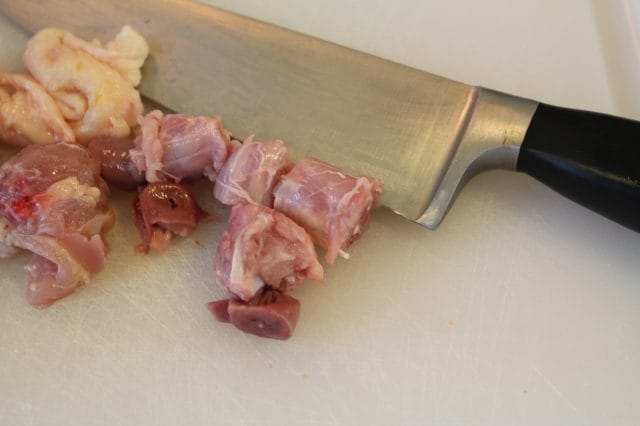 Wash the giblets (the heart, neck, and gizzard), dry them, and chop them into 1 inch pieces.
Wash the giblets (the heart, neck, and gizzard), dry them, and chop them into 1 inch pieces.
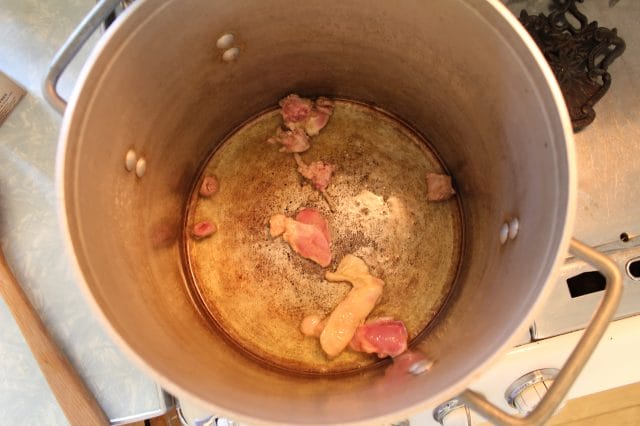 Drop the chopped giblets into a pot sizzling with about a tablespoon of olive oil.
Drop the chopped giblets into a pot sizzling with about a tablespoon of olive oil.
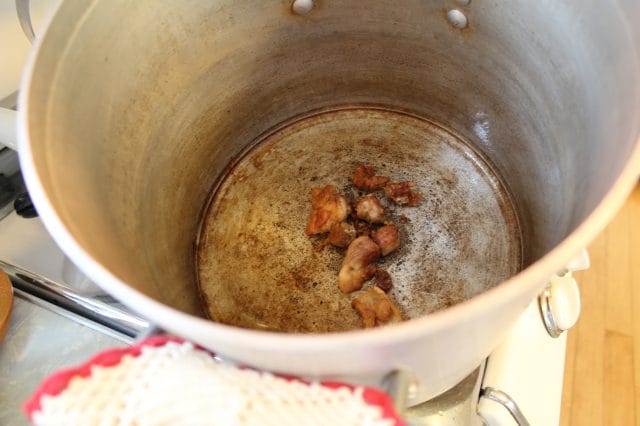 Brown them well over high heat. When they’re dark brown, deglaze the pan by pouring about a cup of water into the pot; immediately begin to scrape the bottom of the pan with a wooden spoon to get up all the little bits and pieces clinging there. There’s a huge amount of flavor in those bits and pieces!
Brown them well over high heat. When they’re dark brown, deglaze the pan by pouring about a cup of water into the pot; immediately begin to scrape the bottom of the pan with a wooden spoon to get up all the little bits and pieces clinging there. There’s a huge amount of flavor in those bits and pieces!
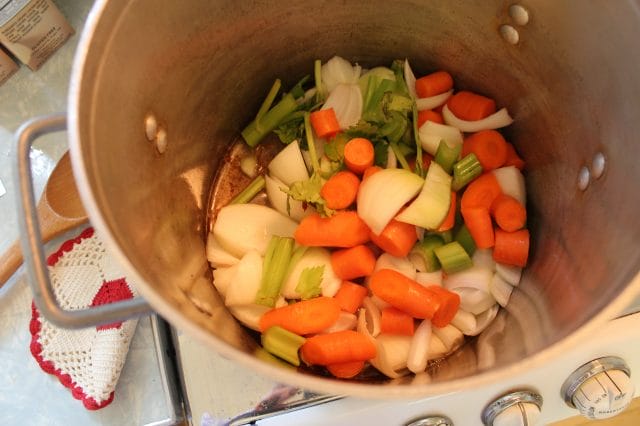 Add chopped carrots, chopped onion, and chopped celery; put in whole black peppercorns, a handful of parsley, and a couple of bay leaves. (You should never salt stock — how much salt to add will depend on what you do with it later.)
Add chopped carrots, chopped onion, and chopped celery; put in whole black peppercorns, a handful of parsley, and a couple of bay leaves. (You should never salt stock — how much salt to add will depend on what you do with it later.)
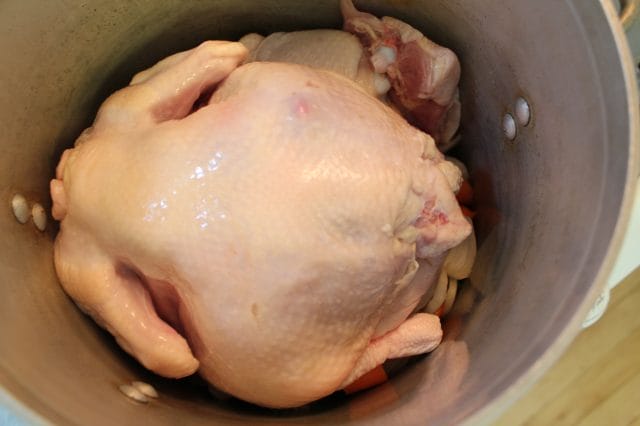 Put your washed chicken on top of the vegetables. (I had a couple of extra thighs in the fridge so I added them too.)
Put your washed chicken on top of the vegetables. (I had a couple of extra thighs in the fridge so I added them too.)
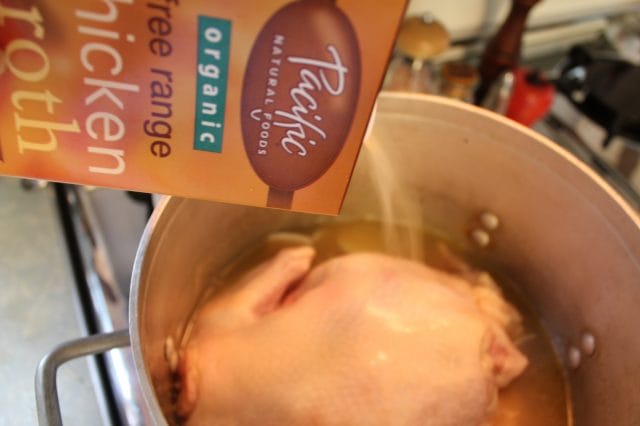 Pour in a container or two of organic chicken stock; then add cold water until the chicken is submerged.
Pour in a container or two of organic chicken stock; then add cold water until the chicken is submerged.
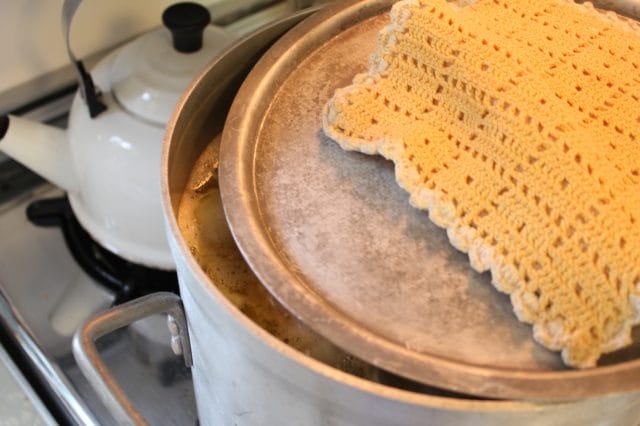 Bring the pot to a boil, reduce heat to simmer; set the lid off to the side, and cook for about an hour until the chicken is done.
Bring the pot to a boil, reduce heat to simmer; set the lid off to the side, and cook for about an hour until the chicken is done.
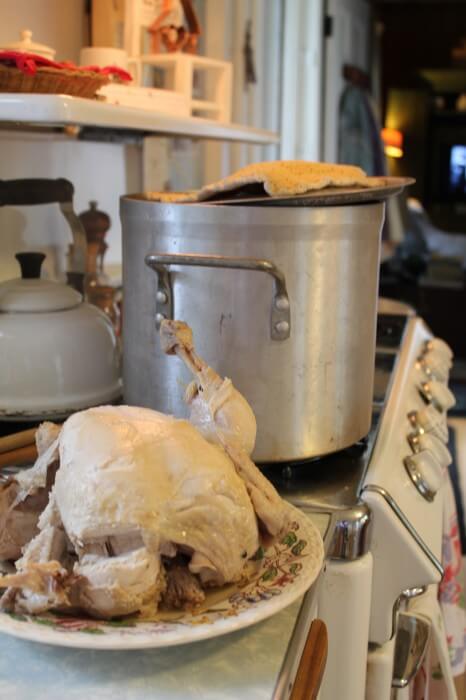
When it’s just done and beginning to fall apart, use a couple of big wooden spoons to remove the chicken from the stock onto a plate; the stock can continue simmering while the chicken cools to the touch.
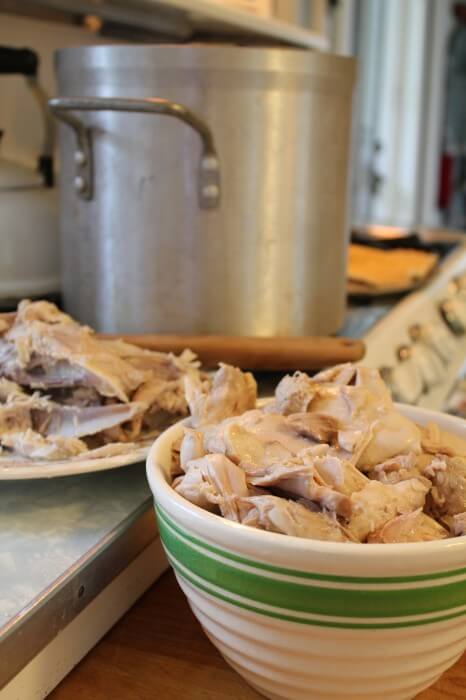 When the chicken is cool, remove the meat to a bowl; put the bones, the carcass, and the skin back into the stock; refrigerate the cooked chicken. Partially cover the stock pot again, and let it simmer for at least six hours, but as long as ten is fine.
When the chicken is cool, remove the meat to a bowl; put the bones, the carcass, and the skin back into the stock; refrigerate the cooked chicken. Partially cover the stock pot again, and let it simmer for at least six hours, but as long as ten is fine.

All this time your house is being inundated with home cooking smells . . . when your friends drop in for tea, coming in to your warm and cozy kitchen, there you are, adorable in your wonderful house, fooling around with things like stock pots and wooden spoons, being a perfect homemaker with no trouble at all.
 The stock requires almost no attention while it bubbles away the day, stir it once in a while and add more water if you need to. You can even take a nap while this is happening, and still feel like you’re accomplishing something! It’s the perfect cooking project!
The stock requires almost no attention while it bubbles away the day, stir it once in a while and add more water if you need to. You can even take a nap while this is happening, and still feel like you’re accomplishing something! It’s the perfect cooking project!
Once the stock is done, it will need to be strained — depending on your kitchen set-up, you can figure out how to do this, but here’s what I worked out.
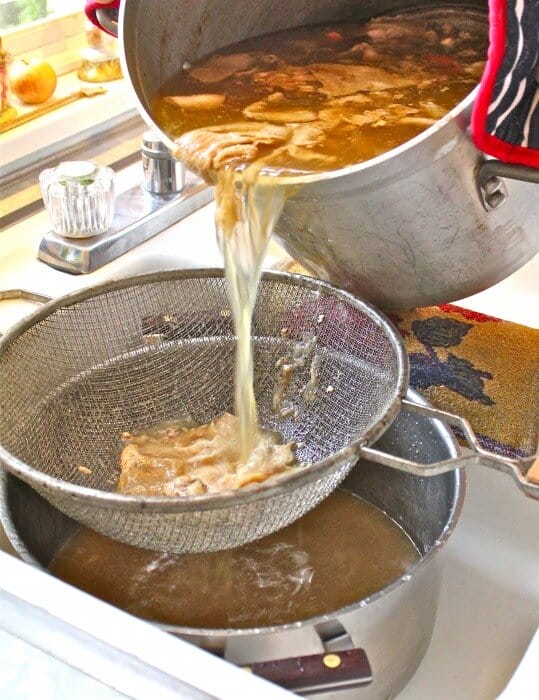 I put another very large pot in the bottom of my sink, hang my basket strainer over it, and pour the stock through it — I let it drip through until all the goodness is in the pan.
I put another very large pot in the bottom of my sink, hang my basket strainer over it, and pour the stock through it — I let it drip through until all the goodness is in the pan.
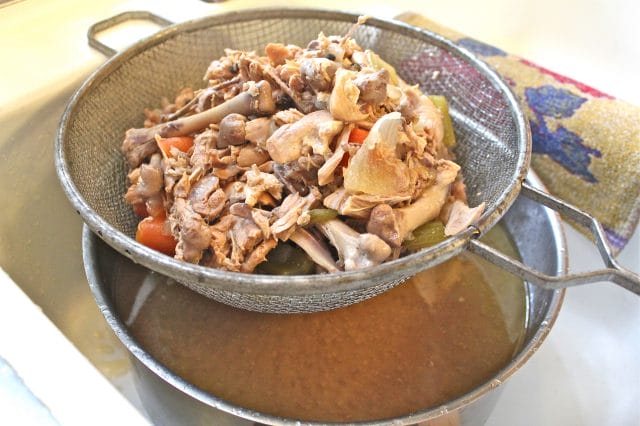 I shake the strainer a bit, leave it for about twenty minutes until the dripping stops. Then I toss all those bones and things into the trash. After cooking for so many hours, every bit of the goodness that was in them is now in the stock!
I shake the strainer a bit, leave it for about twenty minutes until the dripping stops. Then I toss all those bones and things into the trash. After cooking for so many hours, every bit of the goodness that was in them is now in the stock!
 Put the stock in the fridge for at least twelve hours (do not cover, stock will sometimes sour if it’s covered before it’s cool) . . . until it looks like this:
Put the stock in the fridge for at least twelve hours (do not cover, stock will sometimes sour if it’s covered before it’s cool) . . . until it looks like this:
 The fat has risen to the top. It’s very easy to scoop it off and throw it away! And underneath you have essence of organic vitality. The cure for the common cold.
The fat has risen to the top. It’s very easy to scoop it off and throw it away! And underneath you have essence of organic vitality. The cure for the common cold.
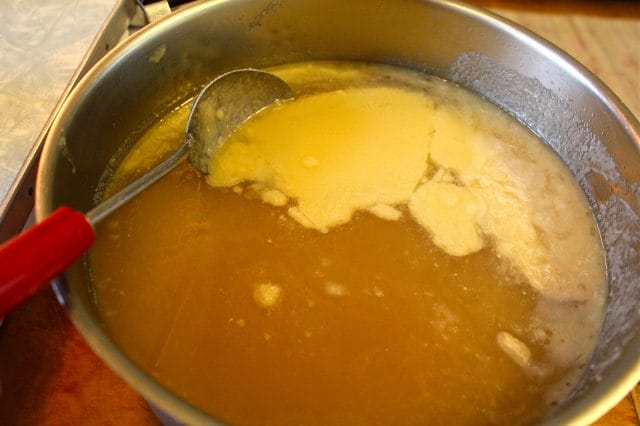
Use it in any recipe that calls for chicken stock (and notice the difference!), you can boil it down to thicken it a bit and freeze it in ice cube trays so you always have a little instant gravy; you can make a huge pot of soup and freeze it in serving-size containers; you can make my delicious ginger chicken and vegetables, or my Chicken Soup.
C H I C K E N S T O C K
(from my Autumn Book page 56)
- 1 large whole chicken w/giblets (it doesn’t matter what the exact weight is)
- 1 Tbsp. olive oil
- 2 large unpeeled brown onions, quartered
- 3 or 4 carrots, cut in two-inch chunks
- 3 or 4 celery ribs, roughly chopped
- a handful of fresh parsley
- About 20 whole peppercorns
- 2 bay leaves
- 1 or 2 containers of store-bought organic chicken broth or stock
Wash chicken and set aside. Discard the liver; wash, dry and roughly chop the rest of the giblets and neck. Add to hot oil in deep soup pot. Over high heat, cook, stirring 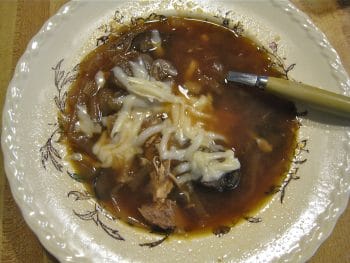 occasionally. When giblets are very brown, add 1c. water; stir and scrape up the brown bits from the bottom of the pan. Roughly chop the vegetables and add them along with the rest of the ingredients, including the whole chicken. Pour in one or two containers of store-bought chicken broth; add water just until chicken is submerged. Bring to boil, set lid askew, and reduce heat to simmer. Chicken will be done in about an hour. Remove it from pot; cool to touch. Remove meat to fridge, put bones and skin back into stock pot. Continue simmering for 5 or 6 hours more; add more water if needed. Turn off heat and let cool a bit before straining it into a large pot or bowl; put the stock into the fridge, uncovered, overnight. The fat will rise to the top; you’ll find it easy to lift off and discard. You can stretch the stock by adding more broth or water, or reduce it to make it stronger. Keep covered (after cooling) in fridge, or freeze.
occasionally. When giblets are very brown, add 1c. water; stir and scrape up the brown bits from the bottom of the pan. Roughly chop the vegetables and add them along with the rest of the ingredients, including the whole chicken. Pour in one or two containers of store-bought chicken broth; add water just until chicken is submerged. Bring to boil, set lid askew, and reduce heat to simmer. Chicken will be done in about an hour. Remove it from pot; cool to touch. Remove meat to fridge, put bones and skin back into stock pot. Continue simmering for 5 or 6 hours more; add more water if needed. Turn off heat and let cool a bit before straining it into a large pot or bowl; put the stock into the fridge, uncovered, overnight. The fat will rise to the top; you’ll find it easy to lift off and discard. You can stretch the stock by adding more broth or water, or reduce it to make it stronger. Keep covered (after cooling) in fridge, or freeze.
Try it with this delicious soup . . .

BTW, this recipe came from my first book, Heart of the Home, which was written before I’d heard of immersion hand blenders! These hand-held blenders go right into the pan and make things so much easier; no more “pureeing the soup in batches!”



























SOUNDS DELISH! ADD SOME THICK GRANDMA NOODLES, VEGIES AND CHICKEN AND YOU HAVE A WONDERFUL MEAL. WOULD BE WONDERFUL TODAY – COLD AND VERY WINDY!
I love this butternut squash bisque. I have the Autumn cookbook but it lives in my ski condo in CO and I wanted to make this soup at home in FL. I have tried a number of other soups and always come back to this one.
I’d like to make your chicken broth/stock but was dismayed to see you actually used a store bought boxed broth as your base. I need to avoid all that sodium & other preservative/additives. Do you have a homemade natural version of the pre-made store brand?
You can use just water, which is the traditional way to make chicken stock, all flavor comes from the chicken ~ that’s how my grandma did it, and it’s perfectly deliciously fine. I decided to add organic chicken broth because I like to give mine even more strength; they have low sodium too and there are no preservatives or additives in it.
Why do you toss the “liver”?
I don’t care for the flavor in the stock, it’s too strong — if I’m making a pate I keep it, otherwise, I’m not personally a huge liver person.
I have found that removing the bones after they have cooked a couple hours and crushing them deepens the marrow content quite a bit and for me has been worth the effort.
If you’re looking to start with water buy two boiler chickens, skinny ones that are cheaper and usually not great for roasting, make a stock with just the chicken and bones, no giblets, then use the stock from that with the giblets to make the finished stock. All the better to have the double richness.
Do you leave the bits of entrals attached to the inside of the carcus or do you scrape/brush it off?
I put the whole chicken into the pot . . . that’s after I’ve fried up the gizzard and heart etc. And when it’s done, I strain everything. I use organic chicken too . . . I hope that answers your question Jon!
You really MUST edit your instructions
You are giving DANGEROUS advice when you say:
“wash the chicken inside and out”
That, along with every other remark mentioning “wash” is advocating an unsafe practice
See the following from FoodSafety.gov:
http://bit.ly/Washing_A_Chicken_01
And the following from USDA:
http://bit.ly/Washing_A_Chicken_02
Yes, things do change. Only unsafe because of course they are allowed to sell us poison chicken these days, talk about dangerous! I wish our “Food Safety” and “USDA” would make the sellers of the chickens do a better job, rather than making the consumers responsible. We didn’t used to get bacteria with our chickens. I think it’s all so they don’t get sued. After all, “they told us so.” I still wash mine. But I’m extra careful to clean up afterwards. I’m glad you wrote, because this is good information for everyone to have. Thank you.
…food-grade hydrogen peroxide, research it.
I have just discovered this site. I really like the look of your website. I was figuring out what to do with giblets when my search led me to you. I’m just a homecook that is in my “happy place” when I can tinker in the kitchen, make the room smell inviting, safe and happy for my family. That’s all I want! Thanks for having a great site to both visit and learn from;
Karen
Hi! I know it’s been a while since you posted this, but I was wondering what size your stock pot was? It looks so huge!!
I also use my leftover turkey carcass to make a wonderful stock every Thanksgiving and Christmas and freeze it in a wide mouth mason jar for later. Sometimes they break but it’s a risk worth taking 🙂
I can only guess, it’s 5 am here and that pot is on a high shelf and I’d have to fill it with water to measure it, so take this with a grain of salt (and a chicken and some onions, etc!) … I think maybe it holds 2 gallons… It’s a standard soup pot … there are bigger, but I think mine is pretty standard. A whole big chicken fits into it, along with other things, that’s the important part. Hope this helps! You can freeze your stock in ice cube trays too, just pull them out as you need them. It’s harder all the time to get chickens with the giblets, but I can’t tell you how much better they make it …. deeper and darker. Sometimes you can buy giblets separately. Happy holidays Melissa! We’ve got the best ones coming!
Thank you so much for getting back to me!! ♥️ I was so excited to see your response:-)
So my largest pot is 10 quart so that will work nicely. Like I said, I’ve done plenty of stock in it, but never with a whole chicken and giblets before, so I’m excited to try!! I am in a soup season mood 🙂 I have also heard of the ice cube tray idea, but I haven’t tried that either. It seems like it would be easier to use than waiting for my quart container to thaw.
Again just thank you for the reply, and being the wonderful and warm creator of some of my favorite things. Keep up the beautiful work!
Wishing you a very lovely Holiday season full of joyful memories!! We do have the best ones coming 🙏🏼
Hi Susan, thanks for this wonderful recipe. It is going to be cold here in Ohio this weekend so I know what will be on my stove! I met you many years ago in Providence at a fundraiser for the Gordon School called “Cooks and Books”, this was in the mid 80’s so I am lucky to have an autographed copy of your book. I have followed you and purchased all of your books, thanks for growing older with me. ❤️❤️
My pleasure . . . it’s been fun!
I believe those bones can be used again for a bone stock. My research tells me that the bones can be used at least twice.
Love the recipe. I used water instead of store bought chicken stock and added my protein bone broth powder. Used it for so many recipes: soups, rice, vegetables, sautee’/reheat chicken on stovetop…
Susan, your broth is my broth, my grandmothers broth! I keep it going all the time. Grandkids tell me no place smells like Sitti’s kitchen. I have also made it in my instant pot, with enough water/broth to almost cover the bird. Pressure cook for 0(zero) minutes and depending on size of chicken (mine about a 5 lb) allowing it to natural release for one hour. Check internal temp at least 161F). Remove cooked bird, strain broth, debone as you do, add bones and skin back to pot and cook at high pressure for One hour or longer. Then natural release . Strain and proceed as you have .
Have always loved your books, calendars, and cozy approach to living , dear girl!
Correction to above: pressure cook chicken for 50 minutes, not zero!